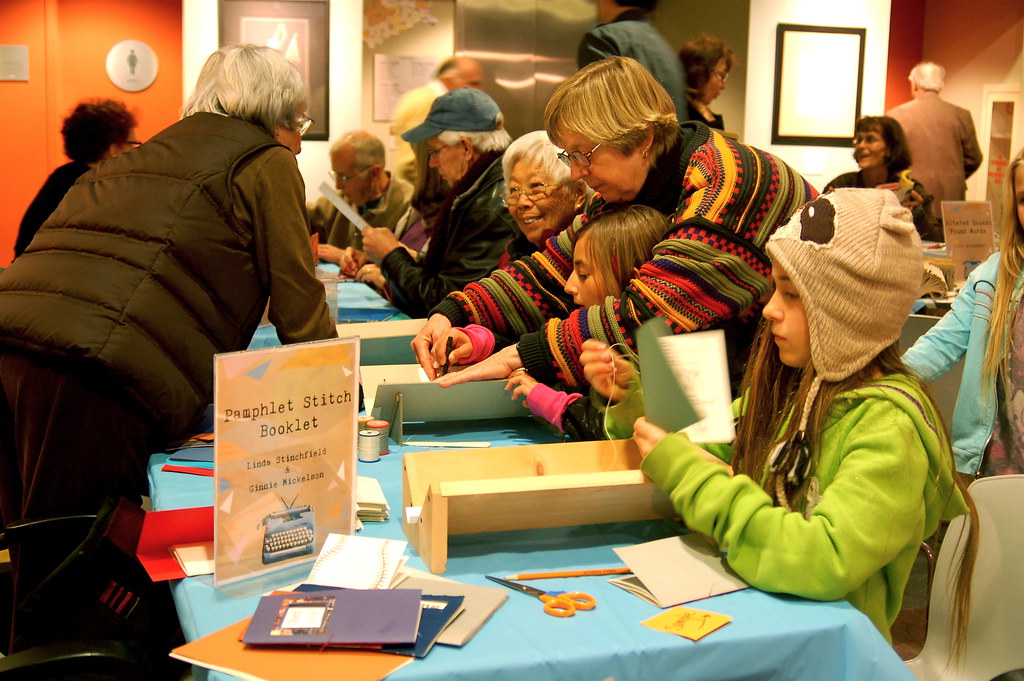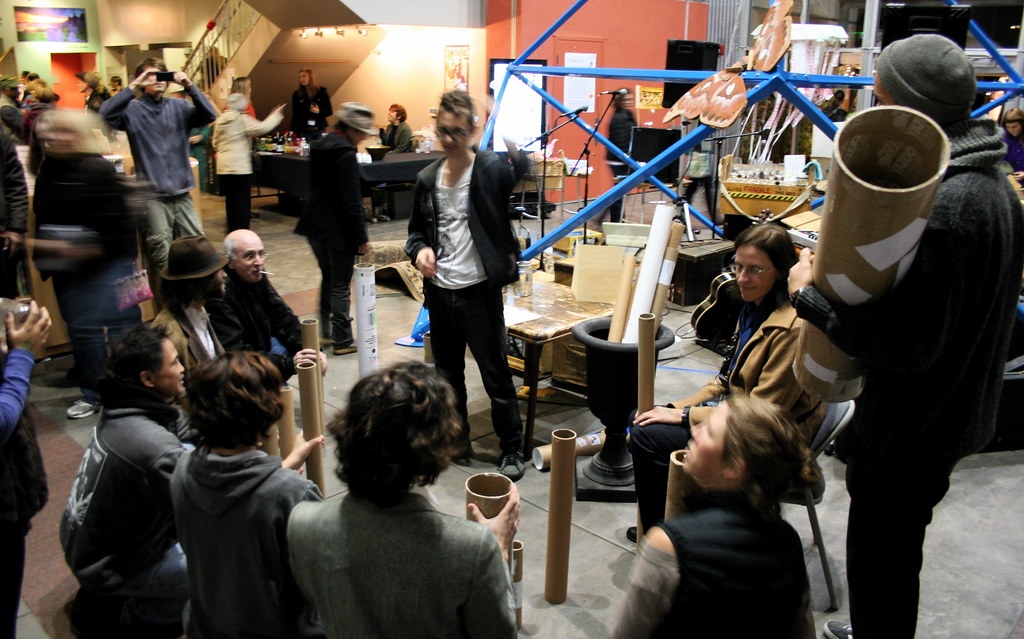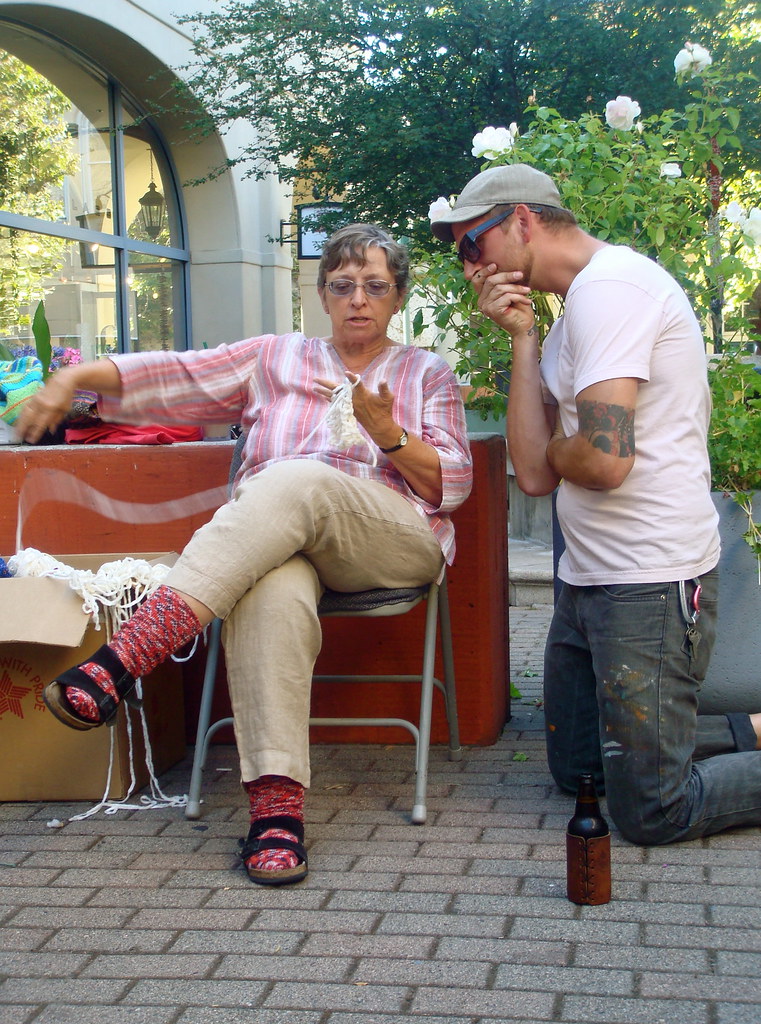 |
| Visitors bond and bridge through participatory experiences at MAH. |
There were times when coordinating a fire art festival while researching social
capital theory made me want to burn my computer. But, overall I felt
overwhelmingly fortunate to be in a job, a museum and a community that I loved
and furthermore to be afforded the valuable time most of us do not have to
devote to further researching, thinking about, reading and discussing the theories
that comprise the foundation of my work.
I chose to focus my thesis on Community and Civic Engagement
in Museum Programs. The purpose of my
thesis was two-fold:
- To research and analyze community and civic engagement practices, methods, theories and examples in other museum programs.
- To apply the results of my analysis to produce a community-driven program design specifically for implementation at the Santa Cruz Museum of Art & History (the MAH).
Assess and Respond to Community Assets and Needs
If you want to activate community engagement in your
programs, you first need to work together with your communities to determine
their diverse needs, assets and interests. This can be accomplished through a
variety of feedback methods conducted both inside and outside the museum. Deeper community relationships through focus
groups or community advising committees can further help museums connect with issues
relevant to their communities while also hold the museum accountable for their
responses.
Two exceptional examples of community committees stand out:
one long standing, The
Community Advisory Committees of The Wing Luke Museum of the
Asian Pacific American Experience and one emerging, the Creative
Community Council of the Children’s Creativity Museum. Both emphasize museums reaching out into the
community to support, understand and experience what the community is already
doing. They stress community engagement should be an asset- over needs-based
approach. It’s not solely about how museums can serve communities but rather
what are the communities’ resources, knowledge and interests that can inform
museum practice? Furthermore, how can museums and communities work together to
share strengths in the community?
Museum programs need to then actively respond to their
communities through a variety of ongoing discursive, collaborative and inclusive
formats that address needs and assets but also invite communities to be active
participants in this process.
At the MAH
Our first program goal is to meet the needs and assets of
our community as defined by our community.
We seek to understand this by listening to and developing ongoing dialogues
with a range of community members. We attentively respond to requests and
purposefully use different modes of feedback to inform program design from our
comment board, social media outlets, conversations and observations both inside
and outside the museum, creative feedback at events such as our Show
and Tell Booth and online visitor surveys specific to our programs. We continuously and actively respond to
requests as well as invite people to be a part of our programs.
We also formed a Creative
Community Committee (C3), composed of a diverse range of
multigenerational community representatives from social services, the arts,
business, education, the city, technology and our board of directors to provide
a multitude of perspectives and expertise.
C3 meets bimonthly to help us understand and brainstorm ways the MAH can
collaboratively implement and address the needs and assets of the vast array of
communities in Santa Cruz County.
Build Social Capital
A crucial theory in community engagement through museum
programs is social capital theory, best defined by Robert D. Putnam, who has
written extensively about social capital in American society in his book, Bowling
Alone. Putnam defines social capital as “connections among individuals-social
networks and the norms of reciprocity and trustworthiness that arise from
them.” Social capital has two main
forms; it should gradually and increasingly encompass both distinct forms of
bonding and bridging to create healthier, wiser, more connected, economically
and socially sustainable communities.
Bonding social capital refers to networks that bring people
together with common interests to strengthen relationships in preexisting
groups.
Bridging refers to an inclusive and outward looking form of
linking different and diverse individuals and groups together to form new
relationships.
Museum programs can be designed to further bond similar
groups together such as families and friends in family workshops such as the
Dallas Museum of Art’s First
Tuesdays. Museum programs can also bridge different groups that
might not typically interact such as the Ulster Folk and Transport Museum’s
Educational Residential Centre, which designed a program specifically to bridge
children of two groups engaged in social conflict, Catholics and Protestants.
Co-created programming that represents the complex range of
voices in communities, offers platforms for communication, collaboration and
shared experiences that can enrich preexisting relationships while also offer a
space for new relationships to form and strengthen. An example of this is The Portland Art
Museum’s partnership with the faculty and students in Portland State University’s
Art and Social Practice Department for their annual Shine a Light
program. The program is an experimental
playground that bridges artists, students, chefs, comedians, hairdressers,
bartenders, dancers, wrestlers and even tattoo artists to produce a community-led
event. Collaborative programs with
diverse groups bring in a variety of visitors causing new audiences to interact
and connect.
At the MAH
Our second community program goal is to build social capital
by strengthening community connections with our collaborators and
visitors. This is a continual process of
bonding within preexisting groups and bridging between groups and individuals
who might not usually interact.
Our programs bond our collaborators by closely co-creating
programs with community organizations which strengthens their individual
internal connections and their relationship to the MAH. For example, the MAH’s Poetry
and Book Arts Extravaganza event partnered with Book Arts Santa Cruz and Poetry Santa Cruz to collaborate
with 61 talented book artists and poets. Evaluation surveys showed that Book Arts Santa
Cruz members felt their bonds were strengthened as they connected with members
in a collaborative capacity that increased group dialogue and stimulated a
sense of pride, identity and vision around their work as a group at this event.
 |
| Cardboard tube orchestra at Radical Craft Night. |
Sometimes we purposefully bridge distinct groups as well
such as middle-aged women from local knitting groups with young college
students interested in street art to yarn bomb our stairwell for Radical
Craft Night. The MAH’s
historic Evergreen
Cemetery brings together the Homeless Services Center and MAH
volunteers or the local rugby team to collaboratively restore the
cemetery. We are constantly looking for
new meaningful opportunities to bridge groups and individuals in our
programs.
Design to Invite Active Participation
Participatory design can be one of the most effective vehicles
for developing relationships, building social capital and engaging with
community members in museum programs.
Implementing participatory activities and constructivist learning
theories allow the learner to actively experiment cognitively and physically,
individually and socially, and to collectively build meaning and knowledge.
Participatory programming highlights alternative narratives, activates
communities and reverses the role of the visitors from consumer to producer,
which in turn engenders more connected and active communities.
The value of participatory experiences is epitomized in FIGMENT, a
free, creative, participatory, non-profit, community art event. This participatory event led by emerging artists
from all backgrounds, engages communities by encouraging a culture of making,
doing, creating and collaboration rather than spectatorship.
The Denver Art Museum has been leading the way with dynamic
programs such as Untitled, which offers
a variety of non-traditional encounters with art and the museum through
participatory, multidisciplinary activities led by Denver’s creative
community.
At the MAH
Our third community program goal is to invite active
participation by offering opportunities at events for visitors to have
meaningful, hands-on, cultural experiences in which they act as contributors and
co-creators, not just consumers. We
scaffold levels of participatory experiences at events that are
intergenerational, multidisciplinary and appeal to different types of learners.
We give visitors a new skill to claim rather than a product and work intensely
with our collaborators to insure active participation in their activities.
All of our events require some level of participation. Sometimes
that results in an artist-led cascading collaborative sculpture of 475
visitor-made scrap metal fish. Other
times it’s a collaborative collage animation workshop, a black light art
activity with red lentils, dodge ball, recording songs to send to loved ones,
writing haikus for strangers or an urban history scavenger hunt on bikes.
 |
| Artists from different worlds, brought together through Street Art Night. |
Final Thoughts
These
are certainly not the only components that constitute successful community
engagement in museum programs but they are central for MAH programs and for our
community. This summer, at our Street
Art Night, when I saw a young graffiti artist learning how to knit from a
woman in her sixties and then taught her how to spray paint or at Experience
Metal, when a motorcycle repairman learns how to operate a new tool from an
art bike welder or when families work together to create their own cardboard
neighborhood or when two individuals who met at one of our events team up to
collaborate- it allows me to see first hand the gradual impact of our goals on
the community and makes me realize all those late nights spent writing my
thesis were completely worth it.
Stacey will be responding to your questions and comments on this post. Enjoy her thesis, share your own example, have a meaty conversation.
Stacey will be responding to your questions and comments on this post. Enjoy her thesis, share your own example, have a meaty conversation.
